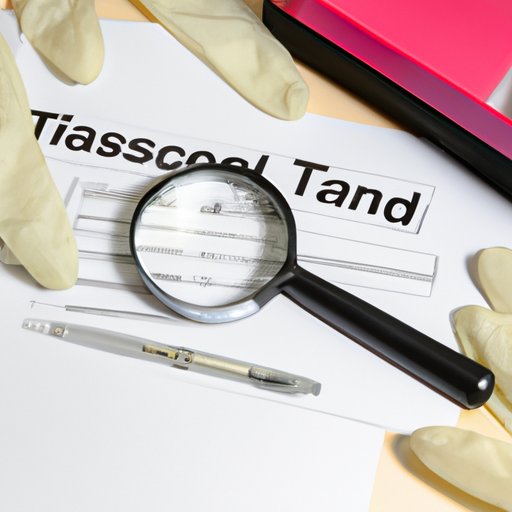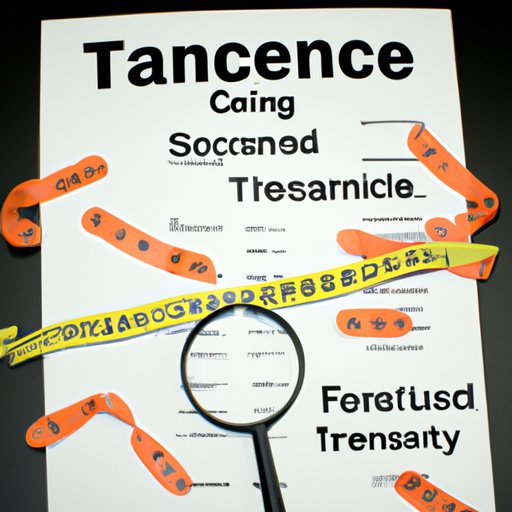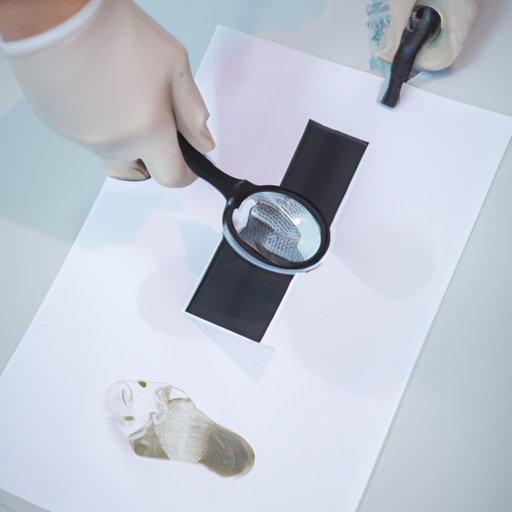Introduction
Trace evidence is a type of physical evidence that can be found at a crime scene, such as hairs, fibers, glass, paint chips, soil, and other small items. This type of evidence is often overlooked, but it can be incredibly useful in criminal investigations. Trace evidence can help investigators piece together a timeline of events and provide valuable clues about who was present at the scene of a crime. In this article, we will explore what is trace evidence in forensic science and how it is used to solve crimes.
Exploring Trace Evidence: An Overview of How It’s Used in Forensic Science
Trace evidence is any type of physical evidence that is left behind at a crime scene. This can include hairs, fibers, fingerprints, shoe prints, and even small objects such as bullets and bullet fragments. Trace evidence can provide invaluable information about the identity of the perpetrator, their movements before and after the crime, and even the weapon used.
The Role of Trace Evidence in Crime Scene Investigation
Trace evidence plays an important role in crime scene investigation. In order to determine what happened at the scene of a crime, investigators must first identify and collect all the relevant trace evidence. This includes collecting samples from the victim, any suspects, and the crime scene itself. Once the evidence has been collected, it must then be analyzed in order to determine if it is related to the crime. For example, if a suspect’s clothing contains traces of blood, it can be compared to the victim’s DNA to determine if they are connected to the crime.
The Types of Trace Evidence That Can Be Found at a Crime Scene
Trace evidence can be divided into three main categories: biological, chemical, and physical. Biological trace evidence includes hair, blood, saliva, and skin cells. Chemical trace evidence includes explosives, drugs, and poisons. Physical trace evidence includes glass, fibers, shoe prints, and tool marks. Each type of trace evidence can provide valuable clues about the identity of the perpetrator, their movements before and after the crime, and even the weapon used.
A Closer Look at Trace Evidence: How it Can Help Solve Crimes
Trace evidence is typically collected using specialized tools and techniques. For example, if a suspect leaves behind a hair at the scene of a crime, investigators can use tweezers to carefully pick up the hair and place it in an evidence bag. The evidence is then labeled and sent to a laboratory for further analysis. In the lab, scientists can compare the DNA of the hair sample to the DNA of the victim or any suspects to determine if they are connected to the crime.

How Trace Evidence Is Collected and Analyzed
Once trace evidence has been collected, it must then be analyzed in order to determine if it is related to the crime. This is done through a variety of methods, such as microscopy, chromatography, and spectroscopy. These methods allow scientists to identify and analyze the components of trace evidence, such as hair color, fiber type, and chemical composition. These analyses can provide valuable information about the identity of the perpetrator and their involvement in the crime.

The Benefits of Using Trace Evidence in Criminal Investigations
Trace evidence can provide valuable information about the identity of the perpetrator and their involvement in the crime. It can also help investigators build a timeline of events and link suspects to the crime scene. Furthermore, trace evidence can be used to strengthen or weaken a case, depending on the results of the analysis. For example, if a suspect’s clothing contains traces of the victim’s blood, it can be used to strengthen the case against them.
Examining the Many Types of Trace Evidence Used in Forensics
As mentioned earlier, trace evidence can be divided into three main categories: biological, chemical, and physical. Let’s take a closer look at each type of trace evidence and how it can be used in criminal investigations.
Biological Trace Evidence
Biological trace evidence includes hair, blood, saliva, and skin cells. This type of evidence can be used to identify suspects and link them to the crime scene. For example, if a suspect’s hair is found at the scene of a crime, it can be compared to the DNA of the victim or any other suspects to determine if they are connected to the crime.
Chemical Trace Evidence
Chemical trace evidence includes explosives, drugs, and poisons. This type of evidence can provide valuable clues about the perpetrator’s identity, their movements before and after the crime, and even the weapon used. For example, if traces of an explosive are found at the scene of a bombing, it can be used to determine who planted the bomb and where it originated from.
Physical Trace Evidence
Physical trace evidence includes glass, fibers, shoe prints, and tool marks. This type of evidence can provide valuable information about the movements of the perpetrator before and after the crime. For example, if a suspect’s shoe print is found at the scene of a burglary, it can be used to link them to the crime.
The Power of Trace Evidence: How It Can Make Or Break a Case
Trace evidence can be incredibly powerful when used correctly. It can provide valuable clues about the identity of the perpetrator and their involvement in the crime. It can also be used to strengthen or weaken a case, depending on the results of the analysis. Here are some examples of cases where trace evidence played a crucial role.
Examples of Cases Where Trace Evidence Played a Crucial Role
In 2009, trace evidence was used to convict Steven Avery of murder. Avery had previously been wrongly convicted of rape and served 18 years in prison before being exonerated by DNA evidence. During the investigation into his later murder conviction, Avery’s blood was found on the victim’s car and his DNA was found on her body. This evidence was used to link him to the crime and ultimately secure his conviction.
In 2014, trace evidence was used to convict Michael Dunn of first-degree murder. Dunn had shot and killed Jordan Davis, an unarmed teenager, during a dispute over loud music. During the investigation, investigators found gunshot residue on Dunn’s clothing, which linked him to the crime. This evidence was used to secure his conviction.
How Trace Evidence Can Be Used to Strengthen or Weaken a Case
Trace evidence can be used to strengthen or weaken a case, depending on the results of the analysis. If the evidence links a suspect to the crime, it can be used to strengthen the case against them. On the other hand, if the evidence does not link a suspect to the crime, it can be used to weaken the case against them.

Uncovering the Mysteries of Trace Evidence in Forensic Science
Working with trace evidence can be challenging due to its small size and delicate nature. In addition, trace evidence can be easily contaminated or degraded, making it difficult to analyze. Despite these challenges, advances in technology have improved the collection and analysis of trace evidence. For example, forensic scientists now have access to more sophisticated equipment such as electron microscopes and gas chromatographs, which can help them identify and analyze trace evidence more accurately.
Conclusion
Trace evidence is a type of physical evidence that can be found at a crime scene. It can provide valuable clues about the identity of the perpetrator and their involvement in the crime. Trace evidence can be divided into three main categories: biological, chemical, and physical. It is typically collected using specialized tools and techniques and then analyzed in the lab. Advances in technology have made it easier to collect and analyze trace evidence, allowing it to play an increasingly important role in criminal investigations.
Trace evidence can be incredibly powerful when used correctly. It can provide valuable clues about the identity of the perpetrator and their involvement in the crime. It can also be used to strengthen or weaken a case, depending on the results of the analysis. As technology continues to advance, trace evidence will become an even more important tool for investigators.

Summary of Trace Evidence in Forensic Science
Trace evidence is a type of physical evidence that can be found at a crime scene. It can provide valuable clues about the identity of the perpetrator and their involvement in the crime. Trace evidence can be divided into three main categories: biological, chemical, and physical. It is typically collected using specialized tools and techniques and then analyzed in the lab. Advances in technology have made it easier to collect and analyze trace evidence, allowing it to play an increasingly important role in criminal investigations.
Final Thoughts on the Impact of Trace Evidence on Criminal Investigations
Trace evidence is an invaluable tool for investigators. It can provide valuable clues about the identity of the perpetrator and their involvement in the crime. It can also be used to strengthen or weaken a case, depending on the results of the analysis. As technology continues to advance, trace evidence will become an even more important tool for investigators.
(Note: Is this article not meeting your expectations? Do you have knowledge or insights to share? Unlock new opportunities and expand your reach by joining our authors team. Click Registration to join us and share your expertise with our readers.)
